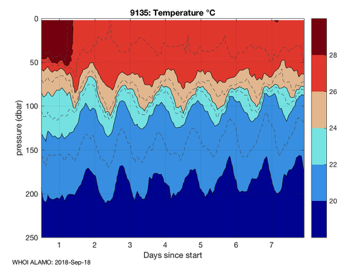On September 11, 2018, a NOAA Hurricane Hunter airplane flew into the path of Hurricane Florence and air-deployed 10 RBRargo CTDs mounted to profiling floats that parachuted into the Atlantic Ocean. The upper-ocean temperature data collected by the profiling floats was used to improve the forecast of the hurricane’s intensity as it headed for the Carolinas.
Florence grew into a Category 4 hurricane as it crossed the Atlantic from its beginnings as an atmospheric tropical wave off the west coast of Africa. It hit North Carolina with 215 km/h winds, up to 900 mm of rain, a large storm surge, and $24 billion in damage.
When preparing for a hurricane, which can include coastal evacuations, it is critical to predict the hurricane’s path, and so too its strength. The Air-Launched Autonomous Micro-Observers (ALAMOs), manufactured by MRV Systems, collected and transmitted CTD data used to quantify upper ocean heat – a hurricane’s fuel – and thus Florence’s strength.
The ALAMOs are compact profiling floats designed to be launched through a chute in the back of an airplane. Before, during, and after Hurricane Florence’s passage, they profiled to 300 m at 2-hr intervals. The RBRargo CTD’s compact size and durability made it an ideal solution for the ALAMOs, sampling under a hurricane.
RBRargo CTDs have been integrated into many floats that have Argo and non-Argo program requirements. RBR CTDs can help with your extreme deployment, as can our full suite of standard loggers. Contact us for help or more info.
